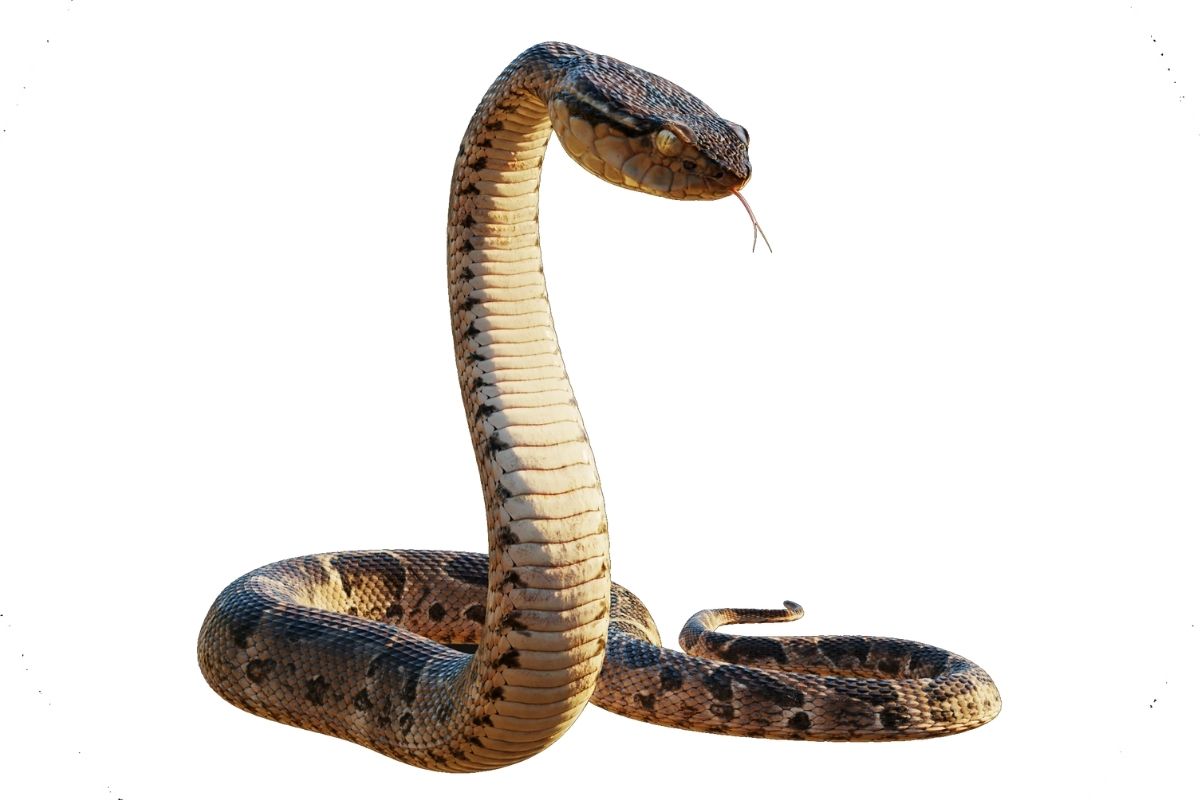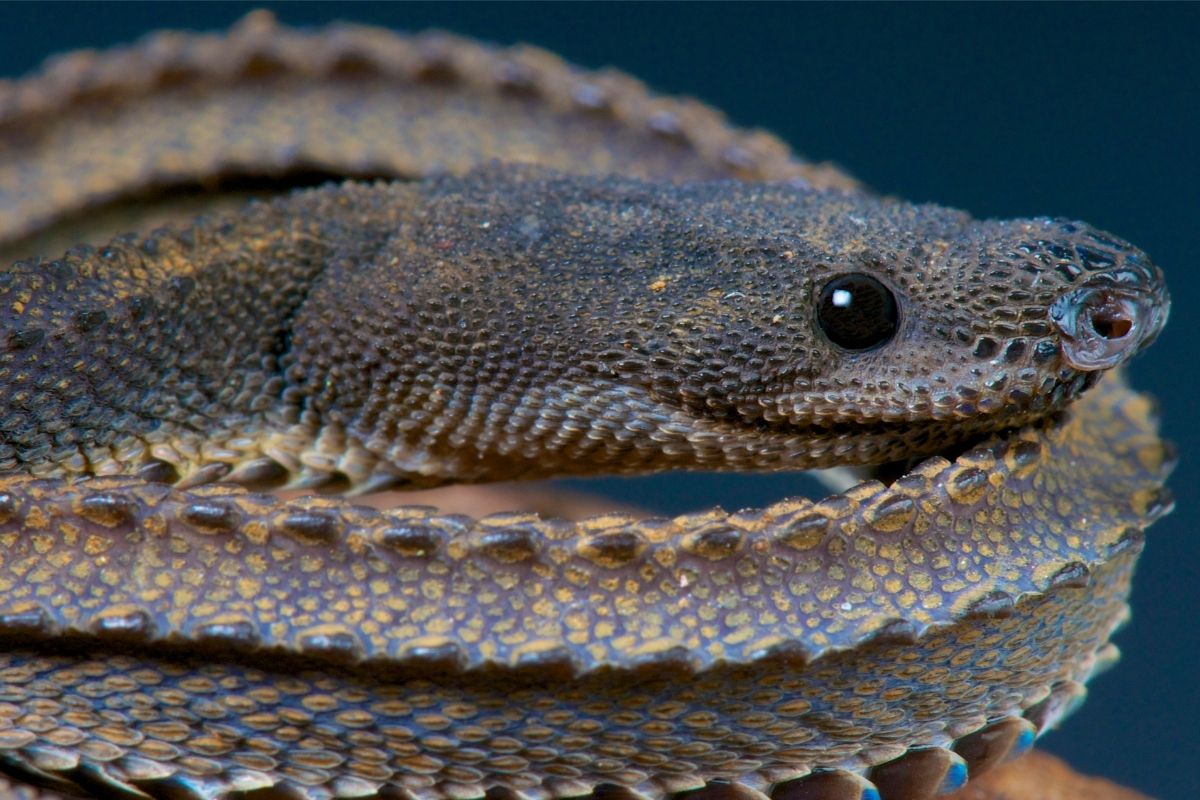Every human society possesses its own inert folklore, stories passed down from generation to generation, often regarding one monster or another that roams the dark places where children aren’t supposed to wander.
But is that all they are? Stories?

Like the Loch Ness Monster, Bigfoot, or the Mothman of Point Pleasant, West Virginia, Japan has long been fascinated by its own figure of cryptid folklore; a mysterious and elusive serpent known as the Tsuchinoko.
But what is it?
What Is The Tsuchinoko?
The name Tsuchinoko means “Child of the dirt” or “child of the hammer” in Japanese.
Also known as “bachi-hebi” in northeastern Japan and the “nozuchi” in yaan-somoku-tsushi, this creature has proven prevalent throughout Asia, appearing in Chinese, South Korean, and even Papua New Guinean folklore.
According to Japanese folklore, the Tsuchinoko resembles a small snake, no smaller than twelve and no larger than thirty-one inches in length, with a very wide, bloated body and a distinctive overall appearance.
Allegedly possessing the ability to speak, having a propensity for telling lies, and a distinct fondness for consuming alcohol, the Tsuchinoko travels around by swallowing its own tail to become a hoop shape.
It allows it to roll around like a wheel and repeatedly jump up and down in the air.
This fact alone shares similarities with the American “hoop snake,” prevalent in Pecos Bill stories, an example of white American folklore from the early 20th century.
This creature, like the Tsuchinoko, could grasp its tail in its jaws and pursue its prey with great speed and maneuverability.
These have usually been written off as mere sightings of sidewinders or even the mud snake (which is known to occasionally rest in a hoop formation).
Reports are still filed every year from concerned Americans claiming to have come face to face with a hoop snake.
The symbology of the snake eating its own tail has been present in mythology for thousands of years (known as the Ouroboros), entering western tradition through Egyptian and Greek mythology.
This representation of the eternal cycle of life, death, and rebirth seemingly has little to do with Tsuchinoko.
Yet still, the recurring symbolism is interesting.
Origins Of The Tsuchinoko

Whilst this symbolism has certainly been true throughout human history, including Japanese prehistory, the first recorded “appearance” of the Tsuchinoko as a “real” creature of Japanese folklore was in the oldest recorded Japanese text, the “Kojiki” written in the eighth century.
Said to inhabit deep, remote mountainous areas, it is not hard to see why this creature became (and remained) so popular in Japanese culture, as well as the reason for its infamous status as a cryptid.
Serpents have long embodied our fears as humans.
Their deceptive nature was characterized in the Bible when it confronted Eve in the Garden of Eden and tempted her to eat the apple.
Perhaps this relates to Tsuchinoko’s fondness for telling lies. The term “snake oil” also denotes something false, poor quality, or untrustworthy.
Of course, snakes became fearful for other reasons as well. Their association with hostility and their venomous bite made them a symbol of death and danger from the times of early humanity.
In Chinese cultures, the snake is feared and associated with evil, something shared in part by the Ancient Greeks, representing their fears in the form of the mythical hydra and the gorgon, Medusa.
Reported “Sightings”
The legend of the Tsuchinoko was revived in the 1970s when an unusual reptile was discovered in the town of Mikata in the Mikata district of Hyogo, Japan.
This creature’s body was also very thick and short, and many residents claimed to have heard the shrill squeak reportedly associated with the mythical snake.
This kickstarted a boom of eyewitness accounts, altered or blurry photographs, and frequent documentaries, talk shows, and segments dedicated to the creature and its whereabouts.
Similarly, in the early 21st century, a further Tsuchinoko “boom” occurred when an Okayama farmer discovered the remains of an unknown creature on his property.
At one time, the city of Okayama even offered a cash reward of 20 million Yen (or $200,000 US dollars) to anyone who could capture and present a Tsuchinoko.
This began another resurgence in the popularity of the creature, and despite the fact that biologists at the time positively identified the creature as a form of keelback snake (albeit an abnormal one), the interest has remained.
However, presently, the creature is still categorized in Japan as a “Yokai,” or a creature of folklore, myth, or legend.
The Tsuchinoko In Popular Culture
As with the widespread popularity of Mothman and the near icon status of cryptid creatures such as Bigfoot, Tsuchinoko has been no different, and where popularity lingers, branding and merchandising are usually close behind.
On May 3rd, an annual Tsuchinoko festival is held in Higashishirakawa in the Gifu prefecture, close to where the beginnings of the legend began.
The festival sees countless people going “Tsuchinoko hunting,” with cash prizes for anyone successful.
References to the creature have been prevalent throughout Japanese cinema and can even be found in anime and manga, featuring in “Pokemon” (represented in the form of “Dunsparce”).
It is also referenced in the “Yu-Gi-Oh” trading card game, where the card “Danger!? Tsuchinoko?” directly references the creature.
The creature also appears as a poison-spitting enemy in the 2003 video game “Castlevania: Aria of Sorrow.”
Similarly, the creature is referenced in the surrounding literature of the video game series “Metal Gear Solid,” shown as one of the cryptids investigated by the CIA operative “Major Zero.”
As well as appearing as locatable animals in “Metal Gear Solid III: Snake Eater” and “Metal Gear Solid V: The Phantom Pain.”
As well as an unlockable codename in “Metal Gear Solid: Portable Ops” if the player manages to remain undetected.
Frequently Asked Questions
What Does “Tsuchinoko” Mean?
As mentioned above, although the creature has many names throughout Japan, the most common is Tsuchinoko, which translates to “Child of the Dirt” or “Child of the Hammer.”
What Is A “Cryptid”?
The term cryptid, meaning “an animal whose existence is disputed or unsubstantiated,” is commonly used to refer to obscure, popular creatures, such as Bigfoot, Mothman, or the Tsuchinoko, who have not been proven to exist in nature.
Is The Tsuchinoko Evil?
Whilst evil may be a strong word to describe the creature, the Tsuchinoko is purported to enjoy telling lies and drinking alcohol. So whilst it may not be “evil” in the truest sense, it is known to be untrustworthy.
So They’re Not Real?
Whilst no concrete evidence has been discovered to place the creature as anything other than local folklore, many creatures in Japan, as well as other parts of the world, have been attributed to their origins, such as the keelback snake, or “rhabdophis tigrinus”.
Conclusion
In conclusion, it is easy to see why the Tsuchinoko, as well as countless other cryptids, continue to share such a prominent place in the public consciousness.
In modern times, when mythology is just that, where we have no time for legends, and where much of the Earth has been mapped out and cataloged, it is clear that people still need something to search for.
It is this searching that keeps the childlike curiosity in our species alive.
The drive that keeps us looking to the skies for signs of extraterrestrial beings, cautiously eyeing deep bodies of water for fear of unknown entities, or avoiding that dicey shortcut home through the dark, scary cemetery.
This sense of the unknown, the unattainable, or the unfound; that “other” that is out there somewhere, waiting patiently for us to come and find it.
